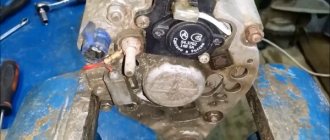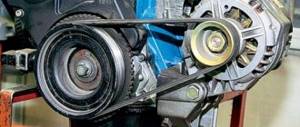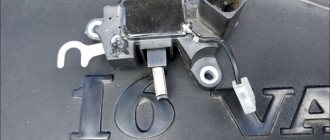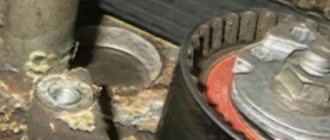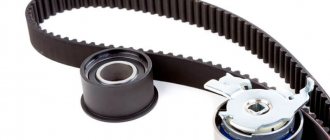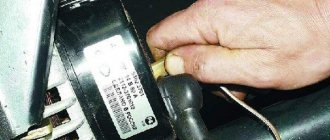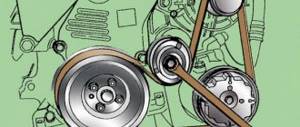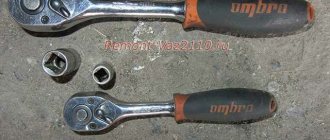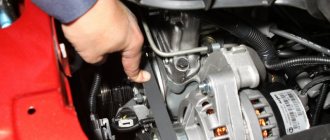09/14/2020 3,367 timing
Author: Victor
A vehicle generator is a device designed to provide energy to the electrical circuits of a vehicle. If the unit breaks down, the on-board network will be powered by the battery, and the latter will not be able to charge due to a breakdown of the generator unit. What to do if the alternator belt breaks, and for what reasons this happens, read below.
[Hide]
Functions of the alternator belt in the car
Is the alternator belt broken? Before you understand how serious it is, you need to understand its purpose. Let's imagine a modern car and its contents. On-board computer, air conditioning and navigation systems, anti-theft device and much more. These gadgets operate using electric current. The load on electrics is great, since the number of such devices in a car is inexorably growing every year.
If the car engine is turned off, they are powered by the battery. As soon as you start the engine, the generator starts working. It not only ensures the operation of gadgets and devices, but also charges the battery and facilitates the transmission of torque from the crankshaft of the internal combustion engine to the shaft of the generator device. The belt may break or break very unexpectedly while driving. In this case, he will not be able to perform his functions. What happens if the alternator belt breaks, we will look into it below.
How can you tell if the alternator belt is broken?
To understand whether the alternator belt has broken or not, pay attention to the following signs:
- A low battery indicator appeared on the dashboard. The icon will light up due to a malfunction of the battery and generator.
- The operation of the headlights has changed. Let's say that when you press the gas pedal they will dim and will not shine as brightly as usual.
What happens when a belt breaks?
What consequences may occur if the alternator belt breaks:
- Lack of power to the vehicle’s electrical network and all its devices due to improper operation of the generator set.
- Gadgets and devices powered by electricity will begin to consume battery power directly.
In addition, the air conditioning clutch in the car and the hydraulic power steering pump will stop functioning.
Belt drive options for internal combustion engines
The drive belt serves to transmit torque from the crankshaft to the generator, but not everything is so simple. The generator is not the only unit that can be driven by a belt. Depending on the make and model of the car, one belt can drive a generator, a gas distribution mechanism, a cooling pump, a power steering column, and an air conditioner. For example, in a Hyundai Solaris car.
If the belt breaks in such a car, the engine will turn off and by squeezing the clutch in time, you can roll to the side of the road by inertia, but no further. Even with a spare one, replacing it in the field is quite difficult. In such a situation, you can only rely on technical assistance or passing drivers.
Crankshaft-generator-hydraulic booster transmission
In most options, in addition to the generator, the belt drives only the hydraulic booster. In this case, you can safely continue driving, but to turn the steering wheel you will need to put in 4-5 times more effort. There are also often options when the rotation of the generator rotor is ensured by a separate belt, and the remaining units are provided by a timing belt or other transmission.
In this case, sparking at the spark plugs will power the battery, but the time and distance that can be driven with a broken belt will depend on the battery capacity, the degree of its charge and, of course, on the power consumption. If the battery capacity and its charge cannot be changed in the current situation, then consumption can be reduced. To do this, you need to turn off all on-board network consumers that you can do without.
To say how far you can drive with a broken alternator belt, you will have to introduce one more variable - the road and the circumstances. On the highway this can be quite a long distance, but in the city, where there are traffic jams and stops at traffic lights, the distance will be shorter. In addition, it is recommended to drive non-stop with the engine turned off, since starting the engine requires a fairly large amount of charge. Each launch is at least minus 4-6 km. In practice, judging by the posts of motorists left on car enthusiast forums, some managed to drive on the battery for almost the whole day, and for some the engine “fell silent” after half an hour.
You should also remember that deep discharge of the battery reduces its service life, so you need to try to choose the optimal route to the nearest place where you can purchase and install a new belt.
Crankshaft-generator-pump transmission
A broken belt transmitting rotation to the generator and pump causes serious problems. If the battery is sufficient to operate the spark plugs and start the engine, stopping the pump will cause the engine to overheat. You can drive in such a car without a belt for only 500 meters in summer, and in winter it can be a little more than a kilometer. Of course, it’s not worth the risk, because overheating the engine can lead to jamming and completely disable the engine without the possibility of recovery.
Under the current circumstances, it is better to call technical assistance or leave the car and hitch a ride to the nearest service station for a new belt. You can also ask passing drivers for help and ask them to tow your car.
Why does the alternator belt break?
The problem that arises is easily solved. It is enough to install a new belt. After this, you can use the car as usual. But how to prevent this unpleasant situation again? Before installing a new one, you need to figure out why the old alternator belt broke. Let's look at the possible reasons:
- operation of the product beyond the recommended period, wear and tear;
- poor quality or defective belt;
- shafts, tensioners or pulleys are not working properly;
- The belt is too loose or too tight.
The alternator belt has a certain service life. We recommend replacing it in accordance with the manufacturer's recommendations without waiting until it breaks. This can also happen due to reasons beyond your control, for example, a low-quality product will last much less, but most often the fault is due to incorrect settings of the transmission system.
The device consists of two pulleys on shafts connected to each other by a belt, as well as a tensioning unit. If the pulley deviates from the plane of operation, the generator belt may break due to overheating or destruction of its elements.
We recommend
“Checking the tension of the generator belt: how to prevent breakage” Read more
Pay attention to the tension of the unit. If it is too weak, the belt slips without engaging the surface of the pulley. In this case, the belt loses its elasticity, overheats and subsequently breaks down. If the product is over-tensioned, it stretches, causing the reinforcing fibers to break. To answer the question why the alternator belt broke, you need to consider possible additional reasons:
- Failure of the tensioner roller . It also has a service life, failure to comply with which can lead to unpleasant consequences. Replacing the product will solve the problem.
- Loosening the fixation of the generator unit and hydraulic power steering . The fastening may crack and break the straps. Most likely the problem is the bending of the generator bracket; the reason for this needs to be found.
- Generator device protection is not installed . In this case, dust, dirt, pebbles, branches, leaves and much more fly there.
- The generator or pump is jammed . This happens very often. Check whether the on-board voltage in the generator has dropped using a voltmeter, and for the pump, use the temperature readings of the internal combustion engine.
- Negligent attitude towards car electrics . “Consumers” of electric current include an emergency sign, external lighting devices, a radio and audio system, wipers, etc. When they are turned on at the same time, the load on the generator device increases, as a result of which it rotates worse and the belt turns.
Why did the alternator belt break? How to establish the true cause? Experts recommend paying attention to the belt itself. Determine which side it is worn out on and analyze what could have caused this.
Pulleys and Alignment
So, why do belts break? Experts say one of the main reasons is that the pulley is installed crookedly. Lack of mutual alignment leads to the fact that the belt rotates incorrectly, touches various mechanisms with its sides, and quickly wears out.
It happens that the pulley on the power steering pump is placed backwards, incorrectly. Again, no alignment. The pulley is rearranged, the problem disappears.
Crankshaft pulley
It doesn’t hurt to always check another pulley – the crank pulley – for runout. Lack of mutual alignment can also occur due to a crooked crank shaft pulley.
To check the runout, just use a dial indicator.
It is also recommended to check the runout on the generator itself and on its tensioner. Such diagnostics will help determine whether there is a distortion.
A simple inspection of the pulleys is the first thing a caring car owner does. First of all, it is determined whether they are coaxial to each other. This is done like this: if the belt is pulled straight with a string, then the pulleys are in the same plane.
Attention. For V-belts, skew is allowed, but not more than 1 mm per 100 mm.
Alignment is an important thing. Checking it is the first step! It happens that not only the pulleys, but also the units themselves are crooked. For example, a non-original pump may be installed on a car. You check it and see that the difference in size from the hub to the base is very large.
It happens that pulleys come across prefabricated ones. That is, they are made from two halves using spot welding. When the belt is tensioned, the welding may fail and fall off. The tension will push the pulley halves apart, the belt will begin to fall into the resulting gap and tear.
The pulley may also not be original. That is, with a smaller diameter. In this case, a large load will appear on the generator, the belt will begin to slip, and accordingly, its sides will wear out.
It is, of course, better to replace such a pulley, but there are craftsmen who add washers, etc. This technique can achieve alignment, however, not always. You straighten one element, and then you notice that the power steering has gone out of plane or something else.
For reference:
- Pulleys from VAZs are not suitable for many cars due to the smaller diameter of the mounting hole;
- GAZ vehicles often have different planes of rotation, although the diameter may be the same.
Another reason is burrs on the pulley plane. They greatly wear out the rubber material of the belt and can create a step on the product, thereby shortening the service life and causing a break. In some cases, due to burrs, it is not possible to drive even a week with a new belt.
Mutual alignment
Burrs are nodules in the form of metal points that rise above the plane of the pulley. It is clear that this is not acceptable. You should go over them with a file, sand them, in a word. After this, the belt will serve its life, at least for at least 1 year (active operation of the machine).
Finally, the pulley itself may be too stiff. For example, this is observed on old domestic cars. You install new belts, but they are not designed for such metal - Soviet steel, stamped and non-separable design. It is better to replace such a pulley with a solid one made of some light alloy.
It is noteworthy that if the alignment is incorrect, the battery does not hold a charge for a long time, because the belt twists. That is, the gene no longer produces the required voltage, since it is not functioning correctly. All this can be determined by the battery, which quickly runs out.
So, the first reason why a belt can break is problems with the pulley and lack of alignment. Pulleys are often installed incorrectly; they may have differences in plane, burrs, etc. The pulleys themselves may not be original, prefabricated, or too hard.
Article on the topic: How to get a car loan without a down payment on a used car
Is it possible to drive if the alternator belt is broken?
Car owners often wonder whether it is possible to drive if the alternator belt has broken. Yes, you will be able to continue your journey, but you will be able to cover a short distance, depending on the battery charge. Therefore, if such a problem happens to you, we recommend driving to the nearest car service center.
Remember to turn off devices that consume electrical energy, such as air conditioning, audio system, GPS navigator, external and internal lighting.
Of course, if the problem happened at night, you need to leave the headlights on, because it is unsafe to continue driving without them. When you arrive at the repair site, do not turn off the engine, as starting it again will cause the battery to discharge faster due to the additional load. But still, if the alternator belt breaks, we do not recommend further movement.
It is worth considering that in modern car models, the generator unit and pump are driven by one belt. Driving without circulation of the engine coolant can lead to overheating and serious repairs. It is also better not to completely discharge the battery. Therefore, if you find yourself in a similar situation, use the services of a tow truck that will take your car to the nearest car service center.
How to tighten the alternator belt
The question of how to tension the generator belt can be easily resolved using an adjusting bar and an adjusting bolt. Using a strap, tensioning the alternator belt is not difficult.
- The nut located on the bar is unscrewed;
- The position of the generator is adjusted using a handy object (a pry bar will do);
- The new position of the generator should be secured with a nut.
The belt drive is adjusted using the adjusting bolt according to the following scheme:
- The generator mounts are loosened at the top and bottom;
- The adjusting bolt turns;
- The generator is removed from the block, and the tension is checked at the same time;
- Tighten the generator mount.
More modern and simpler is adjustment with a tension bolt.
What to do first if the alternator belt breaks on the road
The most important rule when the alternator belt breaks is not to panic. If this happened within the city limits near an auto parts store or service station, you can drive to them yourself. Otherwise, we recommend using materials you have on hand to replace the belt. Allowed to use:
- rope;
- tights;
- tie;
- a belt strap with ends connected using wire staples;
- old wheel tube.
The selected material must be very durable. Let's look at the process of replacing an alternator belt with a rope. Fold it in half twice. The tensioner must be lowered to the limit and the lace installed. After this, the roller will tighten and return to its previous position. The rope should bend about 1 cm in the middle, do not loosen it.
The alternator belt broke, but your car has an old inner tube? We can assume that the problem is solved. Cut a ring about 20 mm wide and the desired diameter from it. Place the resulting product on the pulleys.
A belt strap you happen to have on hand can also be used as a replacement. Using two soft wire staples, secure the ends of the belt. As a result, you will get a ring. If rope is used, it must be braided. Having put the product on the pulleys, tie the ends with a strong knot, preferably a double one, leading it out.
How to tension the alternator belt
The generator is mounted on the engine in such a way that it can rotate in a certain range relative to the axis of the mounting bolt. The position of the generator is fixed by an arc-shaped bar with a special slot and a nut. Optimal tension of the alternator belt is performed by observing the following sequence of actions:
- First you need to unscrew the nut that is on the bar.
- Using a mounting paddle or other suitable tool, you need to press out the generator.
- Next, tighten the nut on the bar back.
- Now you can check the belt tension and, if necessary, repeat the entire process.
Signs of an imminent rupture of the alternator belt and preventive measures
A little higher, we talked about the possible consequences of a situation where the alternator belt breaks, and answered the question of whether it is possible to drive on a battery. As you remember, further movement in the event of a breakdown risks serious repairs. This means you need to check for signs of belt wear in advance and take action. How to do it? This information is important for owners of any car - domestic and European.
The alternator belt may break soon if:
- Cracks have formed on the ribbed surface . Carefully inspect the belt ribs lengthwise and crosswise. There shouldn't be any damage.
- Fragments of the belt surface crumble . If there are peeling pieces or crumbs of material on the inside of the product, immediate action must be taken. In this case, the unit may break very soon.
- Damage to the ribbed surface is observed . The material can wear off and accumulate in the recesses of the product.
- Abrasive wear has occurred . Initially, the outer surface of the belt is smooth and shiny, but during use, marks appear on it. The layer can be worn down to the fabric, which indicates its imminent rupture.
- One or more ribs have become detached . During operation, they move to the side, causing them to separate from the base of the alternator belt structure.
- The ribbed surface is worn unevenly. In this case, one rib shows more characteristic signs of wear than the others. During movement, an extraneous sound appears, similar to friction.
We recommend
“Replacing the Honda SRV belt: generator, air conditioning, power steering and timing belt” Read more
- The outer ribs are damaged and worn out . At the same time, the sides of the belt itself become glossy. The process is accompanied by extraneous loud noise during generator operation. This situation often leads to the tightening of the belt into the timing mechanism, resulting in serious damage to the internal combustion engine.
- The ribbed surface is sticky, in the form of scales . Its swelling is observed. This may be caused by engine oil or other liquids coming into contact with the product.
- The low battery icon on the dashboard came on . The indicator appears due to a malfunction of the battery or generator.
- There is noise and extraneous sounds during generator operation . You may hear creaking, grinding, knocking, clicking, chirping sounds.
- Cracks appeared on the outer surface of the belt . Very soon, extraneous sounds will appear and the generator belt will break.
- External lighting fixtures do not function correctly . For example, when you press the gas pedal, the headlights dim, but when you press them they return to normal. This is because when you accelerate, the belt spins faster.
Is the alternator belt broken? How to prevent this from happening again? Do not forget about preventive measures to identify the degree of wear.
Follow the belt service life recommended by the manufacturer. Change the product in a timely manner, approximately every 30 thousand kilometers.
Check the belt tension regularly. It should not be too weak or strong.
Check the condition of the belt every 5 thousand km. If signs of wear appear, replace it immediately. If cracks appear on it, it’s time to buy a new one.
Do not allow engine fluids to come into contact with the belt.
Belt
It is also obvious that the gene belt breaks due to excessive overtightening. The crank shaft damper bends due to this, because it is rubber and cannot withstand heavy loads. After which all the belts begin to tear, new and old.
Generator belt
The belt is often installed incorrectly, backwards. The upper pulling branch is launched under the roller. It is recommended to check the correct installation using the book.
In general, choosing the right belt is a whole science. Beginners often do not pay attention to this and do not take the matter with the necessary degree of seriousness. In fact, a lot depends on the quality of the belt.
Here are just a few points that give reason to reconsider your views:
- Low-grade belts stretch faster and, accordingly, soon begin to slip (as a result, the belt wears out faster and the charge is lost);
- A cheap, low-quality belt produces an unpleasant squeak during operation (the noise is especially loud when starting the engine).
When choosing a belt, you should always remember an important rule - pay attention not so much to price as to quality. Due to the intense competition in the markets these days, manufacturers are forced to come up with different ways to get ahead of their rivals. Increasing the price of a cheap product is one of the options to attract attention (after all, many still believe in the stereotype that if it’s more expensive, it means it’s good).
Conteg belt
There are quite a lot of stories about a low-quality product supplied by a greedy owner. For example. One owner of Renault Megane 2 decided to save money. Instead of Kontiteg I installed a belt from a left company at a cheap price. In the end, everything resulted in a major overhaul of the engine, although such large costs could have been avoided by spending a little more when buying a belt.
And what happened: the low-quality gene belt did not last even 10 percent of its service life and broke. Its branches were wound around the tensioner roller, the other end got under the timing belt, which also came off. As a result, internal engine components flew off and valves were bent.
It is important to understand that the belt is an important thing. It bends around and drives several rollers and pulleys, which increases the load on the element. Therefore, its quality must be at its best; this is obvious logic.
As a rule, experts recommend paying attention when purchasing to products from three well-known manufacturers: Kontiteg, Jites and Daiko.
The conteg is known for its reliability. Of course, they make belts in Germany, and there the quality is all right. Poly V-belts from this manufacturer have long won the love and respect of motorists around the world. According to official data, the service life of products from Kontiteg is only 10 percent lower than that of original belts.
Attention. According to the service book, the original belt must be replaced every 80 thousand km. If these are Kontiteg belts, then you can safely keep them on the generator for 70 thousand km of the car.
Jites is a very popular brand, however, the price of the products is somewhat overpriced. The service life of the products is the same as that of Kontiteg.
Article on the topic: Mazda CX 5 battery
Daiko is also a good choice, although you can also buy Bosch belts. The main thing is not to run into a fake. If the name on the product is printed crookedly, the size of the symbols is increased or decreased, it is better to refuse the purchase. In addition, each represented manufacturer regularly introduces its consumers to new features that are difficult to counterfeit. You just need to be aware.
Well, the simple reason is that the belt does not fit. It is possible to install it, but then problems begin and it breaks. If it is longer, it will begin to sag; if it is short, then it will also not be possible to tighten it properly.
Tension
Incorrect tension causes the gene belt to break.
What should the belt tension be?
You can check the tension like this:
- arm yourself with a 50-centimeter metal ruler;
- check the belt for deflection.
The deflection of the belt transmitting the CM from the crank shaft to the crankshaft should be approximately 15 mm, taking into account the effect of a load of 10 kg per 1 cm of product length.
A narrow metal ruler is placed on top of the crank and generator pulleys. An impact is applied from above - a load of 10 kg/cm. Another ruler measures the deflection. There should be no discrepancies with the readings, otherwise the belt is not tensioned correctly.
Tension adjustment is carried out with keys, a pry bar and a ruler. The setup instructions assume the following:
- the fastening nuts located on the tension bar of the generating unit are loosened;
- The lower bolt securing the generator with the internal combustion engine is loosened.
Now the gene can be moved, thereby adjusting the belt tension until the values converge with the normalized ones.
If after these manipulations it was not possible to adjust the belt, then the problem is most likely in the belt itself. It is better to replace such a product.
Belt replacement diagram
The replacement itself must be carried out strictly according to the instructions. It is better to entrust the work to an experienced craftsman or to carry out the work yourself than to run into an amateur. Replacement errors can be costly!
A few important rules to follow during the replacement process:
- Before carrying out work, be sure to turn off the engine and disconnect the terminal from the battery;
- inspect and check the tensioner during replacement.
So, a bad belt and incorrect tension are the third main cause of breakage.
Reasons why the alternator belt breaks
There are a huge number of reasons why the alternator belt breaks. It is not always possible to predict a broken alternator belt. Therefore, you should carefully monitor the technical condition of the car.
Aging
The main reason for a broken alternator belt is aging. During its service life, the belt experiences enormous loads, from mechanical to thermal. Over time, the elasticity of the belt is lost; it becomes rougher and more fragile; cracks appear, resulting in breakage.
Seized bearings
Another very common problem with a broken generator belt is jamming of the bearings of the mechanisms that drive the generator belt. For example, such as a generator, pump, air conditioning compressor, power steering, etc. To prevent the belt from breaking for this reason, you should listen to the operation of the engine and, if noise appears, eliminate the cause of the noise.
Foreign objects getting under the belt
While driving on the roads, you can often notice various debris or something similar on the road. All this can cause the generator belt to break. Quite often there are cases when stones or sticks get under the generator belt, as a result of which the belt experiences overvoltage and breaks. The same can happen if the car is driven through deep snow, water or mud. In order to avoid such a set of circumstances, it is not recommended to drive without protective boots and generator casings.
What is the danger of ignoring a whistling car alternator belt?
If you don’t figure out why the car’s alternator belt is whistling and you let the situation take its course, such actions can hurt the driver’s pocket. Insufficient production of electrical energy by the generator leads to chronic underloading of the battery.
Over time, the battery loses its charge and one “fine” morning, when you urgently need to get to work, the car simply won’t start. In the most advanced cases, frequent charging of the battery leads to its premature wear. Sooner or later it will require replacement. Its service life will be significantly reduced.
If the reason for the squeaking of the alternator belt is its wear, then ignoring the problem will lead to a complete loss of integrity of the belt and its rupture. As you know, you can’t go far with just a battery. You'll be lucky if the belt breaks in the city.
Extending the life of the alternator belt
So, in order for the alternator belt to last a long time, you need to take care of it. Carefully check for debris and dirt in the belt tracks. Check the tension of the alternator belt promptly and carefully. A properly tensioned alternator belt should rotate 90 degrees. A too-tightened alternator belt will quickly become unusable and lead to a series of breakdowns. The consequences of a tightened belt can be sad. This is mainly the failure of the bearings of the generator, pump, air conditioning clutch and power steering. If the alternator belt is not tightened, the belt may squeak when the headlights or air conditioning are turned on, that is, when a load appears on the belt, it will slip along the pulley, which will quickly render it unusable. It is advisable to buy belts from trusted manufacturers and only ones suitable for a car of a specific brand. It is not recommended to install used belts.


